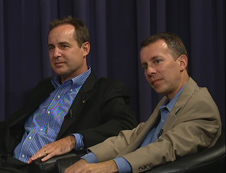October 29, 2010 Vol. 3, Issue 10
Bobby Braun and Steve Altemus discussed informed risk management in technology development and engineering in a Masters with Masters session at NASA Headquarters.

Bobby Braun and Steve Altemus share their stories of experience at the Academy’s fourth Masters with Masters event. Photo Credit: NASA APPEL
For the Academy’s fourth Masters with Masters event, Bobby Braun, NASA’s Chief Technology Officer, and Steve Altemus, Director of Engineering at Johnson Space Center, sat down with Academy Director Ed Hoffman to share stories and experiences in a 90-minute session that streamed live to all NASA centers on September 13, 2010.
Braun talked about what he learned from working on the Mars Pathfinder and the Mars Polar Lander microprobe Deep Space 2. Pathfinder was a success when it landed on the surface of Mars in 1997, while one year later the Polar Lander was a public failure. He indicated that he learned more from the failure, deeming it a necessary part of the learning process. “You’re never as good as you think you are on the day you succeed, and you’re never as bad as you feel on the day you fail,” he said.
The important thing is to learn from failure, Braun emphasized. “If we’re going to push the edge, if we’re going to do cutting-edge work, we have to be continually learning,” he said, “and the day we stop learning is the day this agency stagnates.”
Altemus spoke about the connection between learning from past failures and communications. “We’ve gotten to the point now where we’re talking about informed dissent,” said Altemus, “where people who understand the complexities of the issue that we’re working, they raise the issue up and then we deal with it squarely and maturely as we go forward.”

Bobby Braun and Steve Altemus take questions from the audience at NASA HQ during the Academy’s fourth Masters with Masters event. Photo Credit: NASA APPEL
Altemus said that he believes the agency has matured in its ability to manage risk, and to illustrate this point, he told the story of the STS-119 mission in 2009. Prior to the mission, another shuttle experienced an anomaly with a flow control valve. “We looked at the likelihood of failure and the consequence of failure. We were at the limits of our analysis tools to the point where we could not do any better,” said Altemus. The team held three flight readiness reviews (one of which lasted thirteen hours) before all were satisfied that they understood the problem. The shuttle still flies with this flow control valve risk, said Altemus, but the difference now is that the program understands it and knows how to manage it. (Read the STS-119 case study.)
Braun and Altemus also shared their thoughts on innovation within the agency. “There’s no doubt in my mind that we have the raw materialto be innovative, but what we need to do is remove those stumbling blocks,” said Braun. Programs like the Center Innovation Fund will give innovative ideas a chance to grow, explained Braun. Altemus, who initiated “Project M,” a challenge to put a bipedal robot on the moon in 1,000 days, sees funding such initiatives as an “unshackling” of innovation.
Both Braun and Altemus view the relationship between technology and engineering as healthy and critical to moving NASA forward. “If we have strong relationships between us as a community, technologists and engineering, leadership…we can solve just about anything,” said Altemus. “The foundation of innovation, the foundation of moving us forward is in building strong relationships amongst us all.”





